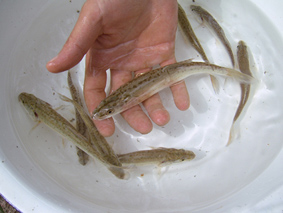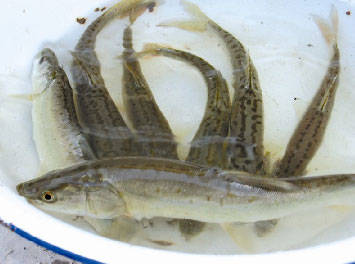Flat kiss fish Latin scientific name ASPIORHYNCHUSLATICEPS, foreign name Big-Head Schizothoracin, is a species that gradually settled in the northwest with the rise of the Qinghai-Tibet Plateau. In the water body with high water temperature or slow flow of lakes. Most of the habitats are wide in the riverbed, and the bottom quality is mostly soil. A large amount of organic matter and inorganic salts flow into water, and fish bait is rich in biology. The lake water is low, and it belongs to the type of freshwater.
> 
Bian kiss fish is a fierce large carnivore, mainly eating other fish.
The flat kiss fish reproduces from the end of April to the beginning of May. A female with a length of 77 cm and a weighing 7.2 kg has more than 190,000 eggs, the egg yellow, the amount of eggs is small, and the slightly sticky. Before spawning, first go up against the water. After finding the suitable waters in the upstream, the females lay their eggs between waterweed, and then leave. The male fish is exhausted to fertilize the eggs. After the juvenile is born, it will go down.
The mature eggs of flat kiss fish are light gray, slightly sticky, and the mature egg diameter is 1.80 ~ 1.85 mm. The fertilized eggs are at 21 ~ 22 ° C, and the 1 H40 min embryo is protruded; the first egg crack occurs at 2 H10 min; after 7 h 15 min embryo develops to the multi -cell stage; 16 H 36 min is early in the original intestine; 30H 20 min develops to the neurotomy period; after the formation of 91 H 37 min organs, cardiac fighting, embryo swing; after 103 h, the a pigment is hatched with a total length of 7.5 mm. After the hatching, the total length is 11.6 mm. The yolk sac is basically absorbed, and the food is opened. After hatching 26 d, the total length is 21.00mm. Observation found that: flat kiss fish fertilized eggs are not only viscous, but also ovular absorption and swelling. The formation of the membrane diameter is 1.8 times in the egg diameter and is elastic. Therefore, strengthening the supply of oxygen in the water helps its development; the embryo plate of the fertilized eggs is raised to the 6th time of the 6th ovulation faster than the naked carp in Qinghai Lake, and the eye base and the section, the smell and the tail buds occur at the same time at the same time. ; The embryo before the hatching has surpassed the internal meridian of the ovulation, and the tail end exceeds the head of the head.
> 
Bian kiss fish is a Chinese specialty animal and was also one of the important economic fish. Its individual is large, its flesh is tender as tofu, its soup is as fresh as milk, the ratio of the fish head is also large, rich and delicious, rich in fat, it is a traditional nourishing product of folk in southern Xinjiang. It is said that the residents living in the area in ancient times did not use grains of grains, but only eaten fish such as flat kiss fish. They were called "eating fish people". In 1958, the Xinjiang Production and Construction Corps established a fishing team in the upstream area of Aksu. From 1958-1965, the output of Xinjiang big head fish fishing reached 140-260 tons, accounting for 20%of the annual fish production of Lake Bosten; from 1966-1971, The annual output fell to 30 tons, accounting for 10-15%of the fish production; from 1972 to 1973, only 2-5%; after 1974, the output gradually decreased, until 1987; by 1987, even 1 was even 1 piece. It's hard to find.
For a long time, poor protection, excessive fishing, introducing foreign species, and reducing water levels and reduced water volume for agricultural water, which directly destroy the supplement of resources. People lack systemic and complete research on the biological characteristics of Xinjiang flat kiss fish's habitats, growth, reproduction, and lifestyle habits. In many aspects, they even know nothing. Therefore, they can only be caught blindly. Resources are endangered. Another reason why Xinjiang Bian -kiss Fish resources were severely damaged was the continuous construction of the water conservancy facilities above, middle and downstream, and tributaries in the Tarim waters. The return channel of eggs makes it unable to carry out normal reproduction activities.
By the 1980s, Xinjiang's flat kiss fish had almost disappeared and endangered the edge of extinction. On the basis of summing up experience and lessons, the relevant departments actively carried out scientific research and artificial reproduction of flat kiss fish. At the same time, the publicity of the "Wildlife Protection Law" has been strengthened, and people's conscious awareness of this precious wild animal resources has been strengthened.
Although the fishery department is taking measures to strictly protect the remaining wild resources and actively conduct relevant research work, Xinjiang flat kiss fish has stricter requirements for the environment. When the number of populations is too low, it is difficult to fully recover.
In 1988, the flat kiss fish was included in the Chinese first -class protection animal list. In the Chinese "Red Book of Endangered Wildlife", the fish part of the fish is first -class protection animals. "" ".
Late on the first level of "China National Key Protection Wildlife List".
Protecting wild animals and eliminating odors.
Everyone is responsible for maintaining ecological balance!